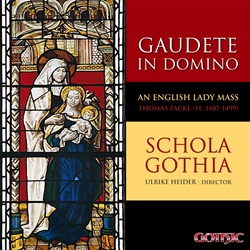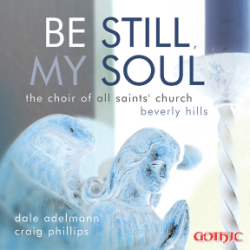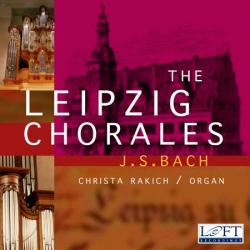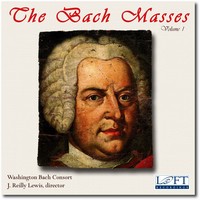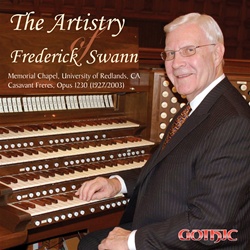 Yesterday
Yesterday we introduced our new release "
The Music of Dan Locklair", so today we are taking some time to introduce you to the pieces on this new release.
Rubrics (A Liturgical Suite for Organ) was a 1988 commission from the Organ Artists Series of Pittsburgh, Pennsylvania, for their tenth anniversary year celebration. The extra-musical impetus and subsequent titles for each movement of
Rubrics are found in the instructions (rubrics) to the services for
The Book of Common Prayer (September 1979 edition).
Rubrics was given its World Premiere in Pittsburgh on April 16, 1989 by organist, Mary Preston.
Peter Hardwick, writing in The Diapason, has called
Rubrics “one of the most frequently played organ works by an American composer.” Movements from
Rubrics were not only heard at the Washington National Cathedral funeral service of President Ronald Reagan in 2004, but also as a part of the January 2009 Martin Luther King Jr. service in the same venue during the Presidential Inauguration of President Barack Obama.
Salem Sonata for organ is in four movements and was composed during late August and September of 2003 on commission from Mr. & Mrs. Mark Welshimer.
Salem Sonata celebrates the 2004 completed restoration of the historic 1800 David Tannenberg pipe organ that was originally installed and dedicated in 1800 in the Moravian Church (now known as Home Moravian Church) in Salem, North Carolina. Last used in Home Church on January 30, 1910, the organ was then disassembled and stored, and eventually loaned to the living history Moravian community and museum of Old Salem in Winston-Salem, NC, where it was under the watchful eye of then Curator, Paula Welshimer.
Meticulously restored in a period of over five years by the distinguished firm of Taylor & Boody Organbuilders, the rededication of the organ - which included the World Premiere of
Salem Sonata - occurred on March 19, 2004 in a concert by organist, Peter Sykes. The dedication of
Salem Sonata reads as follows:
Commissioned by Mark and Rosanne Welshimer in celebration of the
2004 restoration of the 1800 Tannenberg organ at Old Salem (Winston-Salem, NC)
and in honor of Paula Welshimer Locklair,
whose vision and dedication to the project made it a realityPHOENIX Processional for solo organ comes from a larger composition entitled
PHOENIX Fanfare and Processional for organ, brass quartet and percussion. The original three minute
PHOENIX Fanfare was commissioned in 1979 by Union Theological Seminary in New York City for the February 1980 reopening and dedication of Union's renovated James Memorial Chapel. It was conceived of as an antiphonal composition, with the original brass sextet placed at the rear of the Chapel and the organ and percussion at the front of the Chapel. In August of 1985, the scoring of
PHOENIX Fanfare was reduced to brass quartet and joined with a newly composed processional to become
PHOENIX Fanfare and Processional. It was first performed at the September, 1985, Opening Convocation of Wake Forest University in Winston-Salem, North Carolina. Since then it has been used as both a popular recital piece and as a ceremonial processional composition, including use for many years as the commencement piece for The Juilliard School in New York City. The organ solo version of
PHOENIX Processional was done by Dan Locklair in 1996 and it is that version which is heard on this recording.
Celebration (Variations for Organ) was commissioned in honor of the 20th anniversary of J. Patrick Murphy as Director of Music Ministry at First Presbyterian Church, Greensboro, North Carolina. First performed by Mr. Murphy at First Presbyterian on 11 May 2003,
Celebration was composed during the late autumn of 2002 and completed on 7 January 2003 and is inspired by the scripture"…thanksgiving, and the voice of melody" (Isaiah 51:3).
Though variations traditionally begin with a statement of the theme, the original theme on which
Celebration is based does not appear until near the end of the piece. The variations are not sectional but, instead, are ongoing. A transposed Lydian mode (C D E F-sharp G A B C) serves as the primary melodic and harmonic basis of the piece. F-sharp is an especially significant pitch in the composition due to its distinctive character as the raised fourth scale degree in the transposed Lydian mode.
The Æolian Sonata for organ was commissioned by Duke University Chapel for a recital on June 2, 2002 by Chapel Organist, David Arcus, celebrating the 70th Anniversary of the Chapel's Æolian pipe organ (1932-2002). The piece was composed between late January and March 2002. The word "Aeolus", meaning the Greek god of the winds, is at the heart of the name of the American organ builder, the Æolian Organ Company, which built this original Duke Chapel organ (their last before merging with the E.M. Skinner Organ Co.). Aeolian is also the name of one of the ancient Greek modes which, later in history, became one of the original church modes (i.e. A – A on the white notes of the keyboard). The Aeolian mode, as well as the pitches "A" and "E", are important compositional building blocks for
The Æolian Sonata.
In three movements,
The Æolian Sonata musically celebrates the heritage and continued use of the historic Æolian organ in Duke Chapel. Extra-musically, it pays tribute to the spirit of the American people in the aftermath of the 2001 September 11 terrorist attacks. The title for each movement is in a different language, symbolically paying tribute to the outpouring of support that Americans have felt from peace-loving people throughout the world. In a spiritual way, the music of each movement is a reflection on its title, with these words being indicative of a healing nation.
In his June 2003 review of The
Æolian Sonata in The Diapason, Haig Mardirosian writes:
"...What a refreshing delight therefore, to notice a score which literally screams for the appraisal of masterpiece…. If great art is about universals, then Dan Locklair has achieved a summit. Locklair's sonata is that good."
Composed late in 2003,
In Mystery and Wonder (The Casavant Diptych) for organ was commissioned by Casavant Frères, Limitée, of Saint-Hyacinthe (Quebec), Canada, in honor of this distinguished pipe organ builder's 125th anniversary. Multiple premieres of one or both movements of the piece were performed by a host of organists worldwide on Casavant organs during the November 13, 2004 anniversary weekend. Symbolism, as the basis for all musical materials, abounds in both movements and especially in the use of "C" and "F" note codes for "Casavant Frères" (as well as in the unplanned "mystery" that yielded 125 measures of music in the first movement!). Since one of the main melodic ideas from the first movement,
Aria, appears in the second movement,
Toccata, the composition is cyclic. In order for the Casavant anniversary to be celebrated by the widest range of organists possible, a requirement for this commission was that the first movement be technically modest, with the second movement being more technically demanding. Thus, as an option to the entire two-movement composition being played in worship services and/or recitals, each movement may also be played separately. The subtitle of each movement comes from the 18th century English hymn by William Cowper,
God Moves in a Mysterious Way.
Click to purchase
The Music of Dan Locklair

 1. “Joby Talbot: Path of Miracles” Tenebrae directed by Nigel Short, Signum SIGCD078
1. “Joby Talbot: Path of Miracles” Tenebrae directed by Nigel Short, Signum SIGCD078 2. “The Wanamaker Legacy” Peter Richard Conte, organ, Gothic G 49240
2. “The Wanamaker Legacy” Peter Richard Conte, organ, Gothic G 49240 3. “Eternity” National Lutheran Choir, David Cherwien, Music Director NLCA02022 (available from The Gothic Catalog)
3. “Eternity” National Lutheran Choir, David Cherwien, Music Director NLCA02022 (available from The Gothic Catalog)








